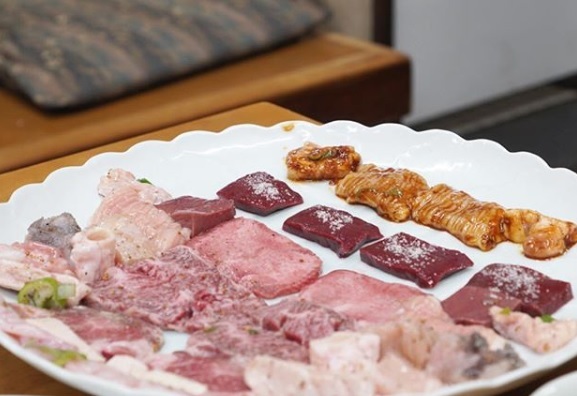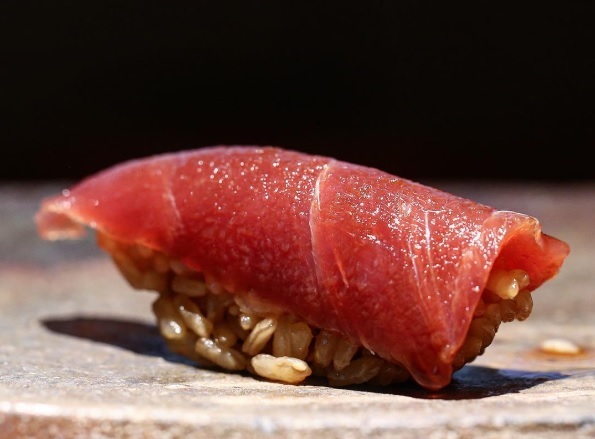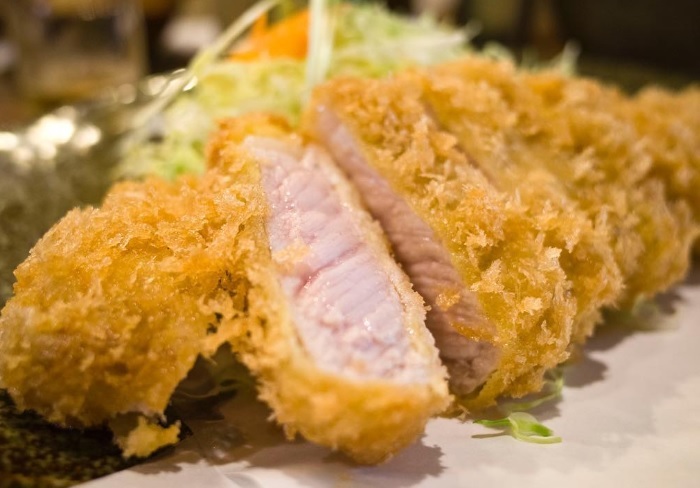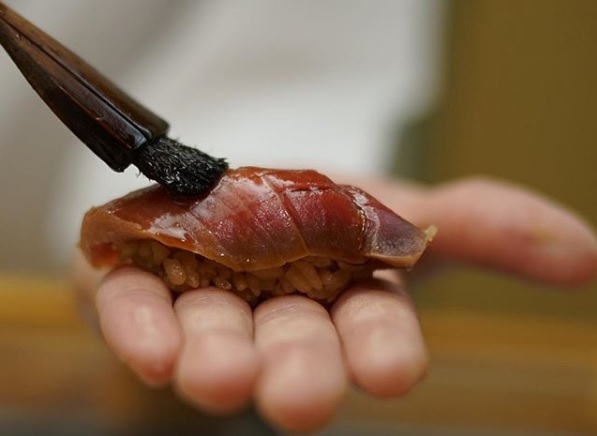Things You Should Know! 29 Classic Edomae Sushi Toppings
We've made this list of popular Edo-mae sushi toppings for those who are not yet too familiar with Japanese fish.
There are lots of factors that go into selecting the right fish to use, including the season, popular fishing areas, method of preparing the fish, and more.
If you thoroughly look over this list before your trip, it's sure to make your time enjoying sushi in Tokyo easier and more understandable!
Be sure to give it a read!
1. Aji (Horse Mackerel)
Aji is a blue-backed fish that has no strong off-putting smell to it, making it appealing to everyone.
Most aji are caught with nets, but varieties of aji called "yellow aji" and "golden aji" are fished for with poles and sell for a high price.
Yellow aji has yellowish markings on its back and fins, and while they tend to be on the smaller side, they have fatty meat with a sweet umami flavor.
Aji is available year-round, but it is in season starting in early summer.
When you visit popular sushi restaurants like "Sushi Saito" and "Sushi Arai," you'll find they serve aji topped with a small bit of finely-chopped green onion for seasoning.
2. Aoyagi (Surf Clam)
Aoyagi is a popular shellfish, with a unique fruity but ocean-like aroma.
It is considered in season before its spawning season, from November through March.
Recently, catches of aoyagi from Tokyo Bay have been dropping, while catches from locations like Hokkaido and Chiba Prefecture's Futtsu City are becoming more commonly available.
The aoyagi caught in Tokyo Bay tend to be smaller but brighter red in color, while those from Hokkaido are larger and yellow.
Aoyagi is low in fat and protein, but rich in components like vitamins and calcium.
3. Akagai (Blood Clam)
Akagai is one of the staple ingredients in Edo-mae sushi.
It is colored a brilliant vermilion and has a supple texture, and many people love it for its sweet flavor and ocean aroma.
The akagai from the Yuriage area of Miyagi Prefecture's Natori City is held in very high regard, often considered to be the best in Japan.
It is in season from September through March.
If you visit famous Yokohama restaurant "Nakajyo" while it is in season, you can enjoy super high-quality akagai fresh from the shell.
4. Anago (Conger Eel)
Anago is a staple of "nimono," or boiled or simmered dishes, at sushi restaurants.
It tends to be served in the latter half of omakase (chef's choice) course meals, and many sushi restaurants consider it a piece that is important for ensuring customer satisfaction.
Anago can be found across Japan. While it can be considered to be in season year-round, the anago in Tokyo Bay, which is highly prized in Edo-mae sushi, has a short season from late June through August.
Many sushi restaurants make the sauce for their anago, which brings the whole thing together, by adding to the broth made from simmering the anago for years and years. For example, the sauce at long-standing sushi restaurant "Jinbocho Tsuruhachi" is said to have a history of being built upon for over 100 years.
5. Awabi (Abalone)
Awabi is a luxury sushi topping that is thought of as one of the essences of summer.
There are 4 varieties of edible abalone used in Japan: megai awabi, kuro (black) awabi, madaka awabi, and ezo awabi.
Madaka awabi is the largest variety and is considered to be a true luxury, but in recent years its hauls have been diminishing further and further, and it now makes up only around 1% of all domestic awabi. This has earned it the nickname "phantom awabi."
Many sushi restaurants serve tender awabi that has been simmered with salt and sake, but you can enjoy it served as nigiri sushi at restaurants like "Shinbashi Shimizu," "Sushi Arai," and "Sushi Kimura."
6. Buri (Amberjack)
Buri is one of the iconic winter sushi toppings.
It has a unique flavor that sets it apart from tuna, blue-backed fish, and white-fleshed fish.
The best buri are those harvested in December, when the meat is at its fattiest as the fish prepare to spawn.
The kan-buri from Himi City of Toyama Prefecture are valued highly at market, selling for as much as 5000-6000 yen per kilogram. It's not uncommon for the first kan-buri of the season to sell for as much as 10,000 yen per kilogram (100,000 yen for a 10kg fish).
7. Hamaguri (Orient Clam)
This superstar shellfish is packed with umami (thanks to its high content of succinic acid), and it goes well in a variety of recipes and preparation methods.
When prepared at sushi restaurants, it's common for hamaguri to be "pickled" in a seasoning liquid after being boiled.
As it is typically prepared with old Edo-mae methods, you'll often find it served in more classic sushi restaurants.
The hamaguri from Kuwana City, which is considered to be the highest quality, is in season from May through June.
Unfortunately, Japan's domestic hamaguri yields are on a downward trend.
8. Hirame (Flounder)
Hirame is one of the classic white-fleshed fish used in sushi, alongside madai (red sea bream).
It is also an indispensable fish during the period of late fall through early spring.
The translucent amber flesh is moderately fatty, and when you bite into it hirame has a unique sweetness and aroma.
Hirame that weigh around 2-3kg are considered to be the best quality, and they consequently sell for a higher price. The hirame from Aomori are regarded as particularly high quality.
9. Ikura (Salmon Roe)
Ikura is salmon roe, typically salted.
The roe that is widely considered the best comes from salmon that are still in the ocean, not yet having reached the rivers where they spawn.
Gunkan-maki made with in-season ikura around August create a beautiful harmony of flavors, combining the unique taste of ikura with its dipping sauce, aromatic nori, and the seasoned sushi rice.
During the summer, many sushi fans visit restaurants seeking this peak-quality ikura that absolutely melts away in your mouth.
10. Iwashi (Sardine)
Iwashi is a common fish that has been a staple food in Japan for essentially all time.
While it is cheap, iwashi is packed with high-quality protein and fats.
It is in season from the start of rainy season through summer.
In-season iwashi are both very moist and fatty, so they are first cured with salt to drain excess moisture away, then seasoned with vinegar before being used in sushi.
As iwashi has a strong fatty flavor, it goes very well with acidic sushi rice.
If you get a chance, we recommend trying an amazing piece of iwashi nigiri from "Sushi Arai" or "Sukiyabashi Jiro" during the summer.
11. Kasugo Tai (Young Sea Bream)
Kasugo tai is an iconic springtime sushi topping.
All young tai, including madai, chidai, and kidai, are referred to under the umbrella term of kasugo, but most sushi restaurants that serve kasugo use chidai, which is the most colorful of the varieties.
As the meat of kasugo is somewhat soft and rather moist, it tends to be salted to remove some of the water content and then seasoned with vinegar before serving.
Although its umami and aroma aren't as prominent as those in madai, kasugo remains a beloved and popular summer sushi staple, like "shin-ika (young golden cuttlefish)" and "shinko (young gizzard shad)."
12. Katsuo (Skipjack Tuna)
Katsuo is a hugely popular sushi topping, which is in season for both spring and autumn.
The first katsuo caught along the northern coast from spring to early summer are called "hatsugatsuo" and are highly prized, and the vivid acidity and blood-like aroma of katsuo is considered an iconic flavor of early summer. Hatsugatsuo is hugely popular among Tokyoites, to the point that some say they would "sell off their wives for a taste."
The katsuo that head south are referred to as "modorigatsuo" and are rich in fats as they are preparing to spawn. This has earned them the alternate nickname of "torogatsuo (fatty katsuo)," and they are a hugely popular autumn fish. Modorigatsuo was once rather cheap compared to hatsugatsuo, but it has become exceedingly popular in recent years, now reaching a higher price point than hatsugatsuo.
Recently there have been heavily marbled and fatty katsuo caught when fishermen are looking to catch meji-maguro (young tuna) and buri. These katsuo are referred to as "mayoigatsuo," or "lost katsuo."
Katsuo typically make their rounds around the Pacific Ocean, but some get "lost" within the Sea of Japan. Then, because they continue swimming through the cold Sea of Japan, their flesh tightens up, and the flesh ends up beautifully fatty and has a lovely aroma and flavor.
Katsuo is in season from summer through autumn, but mayoigatsuo are fished up in the winter along with fish like meji-maguro around Toyama Prefecture's Himi, Tottori Prefecture, and Yamaguchi Prefecture's Senzaki. Not many mayoigatsuo are fished up, but they are highly prized among those who enjoy katsuo.
13. Kinmedai (Splendid Alfonsino)
Kinmedai is a fish that is rich in fats, and it is known for its thick texture and rich umami flavors.
When kinmedai is sliced for sashimi, the fat is distributed equally across the slice, resulting in a beautiful melt-in-your-mouth sweet and umami flavor.
As it is a more recent addition to the world of sushi, kinmedai is more likely to be found served at restaurants run by young sushi chefs rather than at long-standing historic sushi restaurants.
Since kinmedai has a relatively high moisture content, it is typically served after being dehydrated with salt and kombu kelp.
The fatty kindmedai served in the winter goes splendidly with sushi rice that is heavily seasoned with vinegar.
14. Kisu (Sillago)
Shirogisu, or Japanese sillago, is a beautiful fish that has been called the "queen of the sea," and it is an indispensable ingredient in both Edo-mae sushi and tempura.
Kisu is in season from May through July.
The flesh of kisu is a translucent white, so it looks like it would be classified as a white-fleshed fish, but as its skin has a rather unique texture, it is typically seasoned with salt and vinegar to help soften the skin.
At Tsukiji Market, the kisu from Hayama and Zushi in Kanagawa Prefecture are considered to be of the highest quality.
15. Kobashira (Surf Clam Adductor Muscle)
Kobashira is a traditional staple of Edo-mae sushi, the adductor muscle of a surf clam served as gunkan-maki.
It is in season from October through February, before its spawning season.
Surf clam has 2 adductor muscles, one small and one large. The large muscles are referred to as "oboshi," while the small muscles are referred to as "koboshi."
Oboshi in particular is prized for its deep umami and aroma as well as visual appeal, so it is considered a luxury product that sells for a high price.
At Tsukiji Market, kobashira from Futtsu City of Chiba Prefecture are considered top quality.
16. Kohada (Mid-Sized Gizzard Shad)
Kohada is one of the most iconic fish used in Edo-mae sushi.
It ends up unpleasant to eat when simmered, grilled, or fried, but if you cure it with salt and vinegar, you can draw out the irresistibly delicious umami of kohada.
It truly is a "fish destined to be used in sushi."
Gizzard shad are referred to by different names depending on where they are during their growth, going from shinko to kohada to nagazumi to konoshiro.
The shinko that show up in markets during the summer do not have a strong umami flavor, but they are popular for their tender flesh, and the earliest shinko of the season can go for tens of thousands of yen per kilogram, outpricing even the highest quality maguro.
Sushi restaurants in Tokyo tend to serve kohada year-round, excluding the season for shinko.
Edo-mae, Ariake, Amagusa....
Following the changes and innovations in shinko depending on season, location, and individual restaurants is truly one of the highlights for sushi fans in Tokyo.
17. Makogarei (Marbled Sole)
Magarei, makogarei, and ishigarei are considered to be the main three varieties of karei, which are flatfish like sole and flounder.
The most valuable karei are those with roe, but makogarei is considered in season during the summer, when its flesh is more flavorful, rather than in the winter when it would be carrying roe.
Unlike hirame, another white-fleshed fish used in sushi, makogarei is typically served fresh, not cured.
There are a significant number of sushi fans who consider makogarei to be "a white-fleshed fish that is even better suited for sushi than madai" thanks to its delicate and refined white flesh.
18. Kuruma Ebi (Japanese Tiger Prawn)
Kuruma ebi is a traditional Edo-mae sushi topping.
While it is considered in season during the early summer, it is typically farmed via aquaculture, so it is available year-round.
The price of kuruma ebi is mostly the same whether it is wild-caught or farmed, and the price depends on the size of the prawns.
The flesh of kuruma ebi bruises and develops an odor soon after the prawn dies, but it can be kept fresh for a longer period of time if packed in sawdust and kept humid, so this is the preferred method for shipping and distribution.
Kuruma ebi of around 25g are the optimal size for using in sushi, and larger ones are even more flavorful.
19. Hon-Maguro (Pacific Bluefin Tuna)
Hon-maguro, Pacific bluefin tuna, is considered to be the best variety of tuna.
Sushi restaurants and gourmands alike are enamored with hon-maguro, from the lean cuts with an acidic iron-like flavor and aroma of blood to the melt-in-your-mouth flavors of the fatty cuts.
As the quantity of Pacific bluefin tuna in the wild is drastically dropping, hon-maguro is even more heavily prized now, sometimes referred to as a "black diamond."
Each of the different cuts of hon-maguro has a different flavor, like the lean "akami," the medium-fatty "chu-toro" cut close from the spine, and fatty "otoro." Flavor also varies based on the size of the fish.
The best maguro are fished up from Oma in Aomori from September through the end of the year.
Maguro is caught using a variety of fishing methods, from pole-fishing to longline fishing, thrown net fishing to stationary net fishing. However, most sushi restaurants prefer maguro that are caught with stationary nets, as this method places the least amount of stress on the fish's body.
20. Saba (Mackerel)
In-season saba, fished up from autumn through winter, is deliciously fatty and sweet. Freshly-caught saba are often used to make sashimi and sushi, and it is common to drain the blood from the fish fresh to preserve it, a practice popularized on the seki-saba from Saganoseki in Oita Prefecture. Saba is an iconic and widely beloved blue-backed fish that has a large amount of flesh dark with blood concentration and a unique smell to it. Shime-saba, which is saba purchased in fillets then salt-cured and seasoned with vinegar, is a delicious and popular way to serve this fish. This preparation is also used in a variety of regional specialties, such as saba sushi and bo-sushi.
Seki-saba: These are masaba (chub mackerel) fished up with poles in the Hoyo Strait, the narrowest part of the Bungo Channel, and unloaded in Oita Prefecture's Saganoseki.
Kinka-saba: These are masaba fished up in the ocean around Miyagi Prefecture's Kinkasan, and unloaded in Ishinomaki Bay. This variety has a particularly high fat content.
Matsuwa-saba: These are masaba that migrate to Tokyo Bay. After their migration, they tend to stay in rather deep currents, and their bodies are colored a glistening gold. While this is a rare variety of mackerel, it is prized for its deliciousness, and it sells for a higher price than even seki-saba.
Even just lightly biting into a piece of saba should reward you with a taste of the sweetness and umami of the fish's fat.
21. Sawara (Japanese Spanish Mackerel)
Sawara is another blue-backed fish related to saba, but it differs in that sawara has a refined flavor without any odor.
When it is in season during the winter, sawara can reach a fat content of around 15%, giving it a delicious melt-in-your-mouth flavor and texture.
As this fish's flesh is rather soft it needs to be firmed up to be used in sushi, so many sushi restaurants cure or broil sawara.
The area between sawara's skin and meat has a unique and characteristic aroma, so it is often served as nigiri with the skin still on.
22. Sayori (Japanese Halfbeak)
Sayori is considered one of the highest-quality white-fleshed fish used in sushi.
This glistening silver fish is in season from late autumn or early winter through spring.
It is often called "a beautiful fish that marks the start of spring" and "an elegant springtime fish," but the sayori caught during autumn are also exquisite.
The refined, odorless flavor of sayori lets you savor a delightfully unique taste.
23. Shako (Mantis Shrimp)
Shako is one of the most iconic Edo-mae sushi toppings.
While it may look a bit off-putting when compared to its other shrimp relatives, its flavor can hold up against standard shrimp - or, rather, it surpasses them.
Shako are traditionally marinated in Edo-mae sushi, using a thin broth made of water, German sugar (or plain white sugar), mirin (some restaurants use sake instead of mirin), and soy sauce. The marinated shako is then boiled in salted water.
The most highly regarded shako come from Koshiba in Kanagawa Prefecture, and many Edo-mae sushi restaurants refuse to use shako sourced from anywhere else.
24. Shima-Aji (White Trevally)
Shima-aji is known for its good flavor, firm meat, and delicately balanced fatty flavor, even compared to other varieties of aji.
Unfortunately, the catches of wild shima-aji have decreased drastically in recent years, so they have been deemed a "phantom fish."
The wild-caught shima-aji that weight around 2kg are considered to be the best, and these can sell for 10,000-20,000 yen each.
Shima-aji are in season from summer through autumn.
The flesh of farm-raised shima-aji is milky white, but the best wild-caught shima-aji have glistening deep pink-colored flesh.
25. Sumi-Ika (Golden Cuttlefish)
Sumi-ika is an indispensable ingredient in both Edo-mae sushi and in tempura.
It is in season from late autumn through early spring.
Sumi-ika has a delightful texture and a pleasantly sweet flavor that pairs beautifully with sushi rice.
The young sumi-ika that show up in the markets during July and August are incredibly popular as a summertime sushi topping, and as most sushi restaurants are all hoping to buy stock during this time it can sell for as high as around 20,000 yen per kilogram.
Young sumi-ika with their delightfully soft texture are truly a summertime delight that you cannot get at any other time.
26. Madai (Red Sea Bream)
Madai is a popular sushi topping known as the king of the white-fleshed fish.
As implied by the saying "cherry blossoms for flowers, tai for fish," tai is historically Japan's most beloved type of fish.
It's commonly thought that the best time for madai is from autumn through spring (so all year other than summer), but its spawning season varies between the north and south, so its season also varies.
The season for the ever-popular tai from the Seto Inland Sea (used in products like naruto and akashi) is March through April (as they spawn in May).
The tai during this season are particularly delicious as they've stored away plenty of fat, and the madai caught during this period are called by names like "sakuradai" and "hanamidai."
Madai served in sushi restaurants are typically cured or dehydrated with salt to amplify the fish's umami flavors.
Many sushi restaurants also serve it with the skin still on for both appearance and preserving the fish's texture.
27. Tamago (Rolled Omlette)
Tamago is typically served as a dessert to wrap up the tail end of sushi omakase courses.
It is made by carefully cooking fresh eggs with a paste of kobashira or shrimp, mirin, vinegar, soy sauce, and a bit of salt.
The dense yet fluffy texture of tamago is reminiscent of the popular dessert from the Netherlands, "Castella."
In the past many restaurants served tamago over sushi rice as nigiri, but lately it is more common to serve it on its own.
28. Torigai (Japanese Cockle)
This popular sushi topping starts showing up in the spring and through summer.
Torigai is particularly sweet compared to other types of shellfish, and it has very little of the odor that many shellfish possess.
It has an incredibly smooth mouthfeel, and the meat is very juicy when you bite into it.
The torigai caught in Chiba Prefecture's Futtsu from the Tokyo Bay were considered to be the highest quality, but in recent years that area's yields have been low, so those caught in Kyoto and Aichi Prefecture have become common as well.
29. Uni (Sea Urchin)
Uni is now one of the most luxurious ingredients used in modern sushi restaurants, alongside maguro.
It was first introduced into the world of sushi around 50 years ago.
The sea urchins themselves are baited with konbu kelp, and the edible portion is the gonads.
There are two types of uni that are commonly sold at Tsukiji Market: bafun uni, which has a deeper color and is incredibly rich, and murasaki uni, which is a lighter creamy yellow color and has a more delicate and refined flavor.
Most sushi restaurants serve the different varieties of uni depending on the season, often offering bafun uni during the summer and murasaki uni during the winter.
Recently the aka uni from Kyushu that hit the markets in July and August have been gaining popularity as well.
Register account first.
Register










Comments 1
1
Leo Saito
chief editor, TokyoTableTripRegarding well-common toppings at edomae sushi restaurants, I've tried putting together some basic details.
By all means, give it a look before visiting a sushi restaurant!